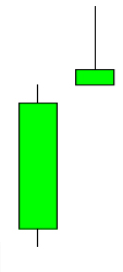SPX Daily Candle was a BEARISH “Shooting Star”…http://stephenbigalow.com/blog/shooting-star/
 Shooting Star
Shooting Star
April 18, 2012
The shooting star candlestick is one of the 12 major candlestick patterns and the Japanese named it the shooting star because it looks like a shooting star falling from the sky with the tail trailing behind it. It is comprised of one candle and it is easily identified by the presence of one small body with a shadow at least two times greater than this body.
Criteria
The upper shadow should be at least two times the length of the body.
The real body is at the lower end of the trading range and while the color of the body is not important, a black or red body should have slightly more bearish implications.
There should be no lower shadow or a very small lower shadow.
A black or red candle on the following day is needed to confirm the shooting star candlestick did occur.
A gap down with a lower close is an even better confirmation that it occurred.
Signal Enhancements
The longer the upper shadow is the higher the potential is for a reversal to occur.
If on the day after this signal occurs, the price opens up lower than the previous day’s close, then the signal has an even stronger confirmation.
The chance that a blow-off day has occurred is increased if there is large volume on the shooting star day, although the large volume in not a necessity.
Pattern Psychology
After a strong up-trend has been in effect the atmosphere is bullish. The price open and trades higher and the bulls are in control. Before the end of the day however, the bears step in and take the price back down to the lower end of the trading range. This creates a small body for the day and could indicate that the bulls still have control. The long upper shadow however, represents that sellers started to step in at these levels even though the bulls may have been able to keep the price positive by the end of the day. A lower open or a black or red candle the following day will reinforce the face that selling is occurring.